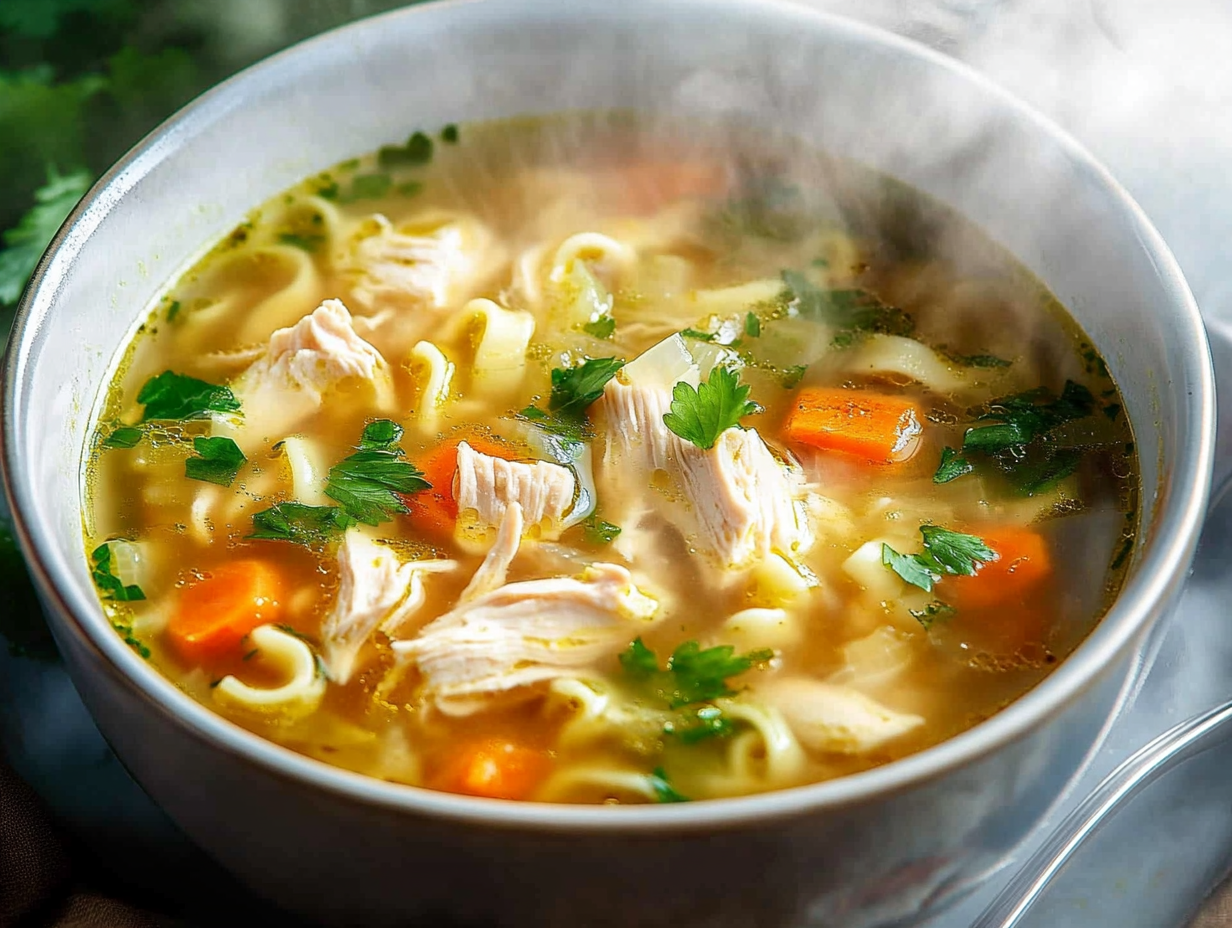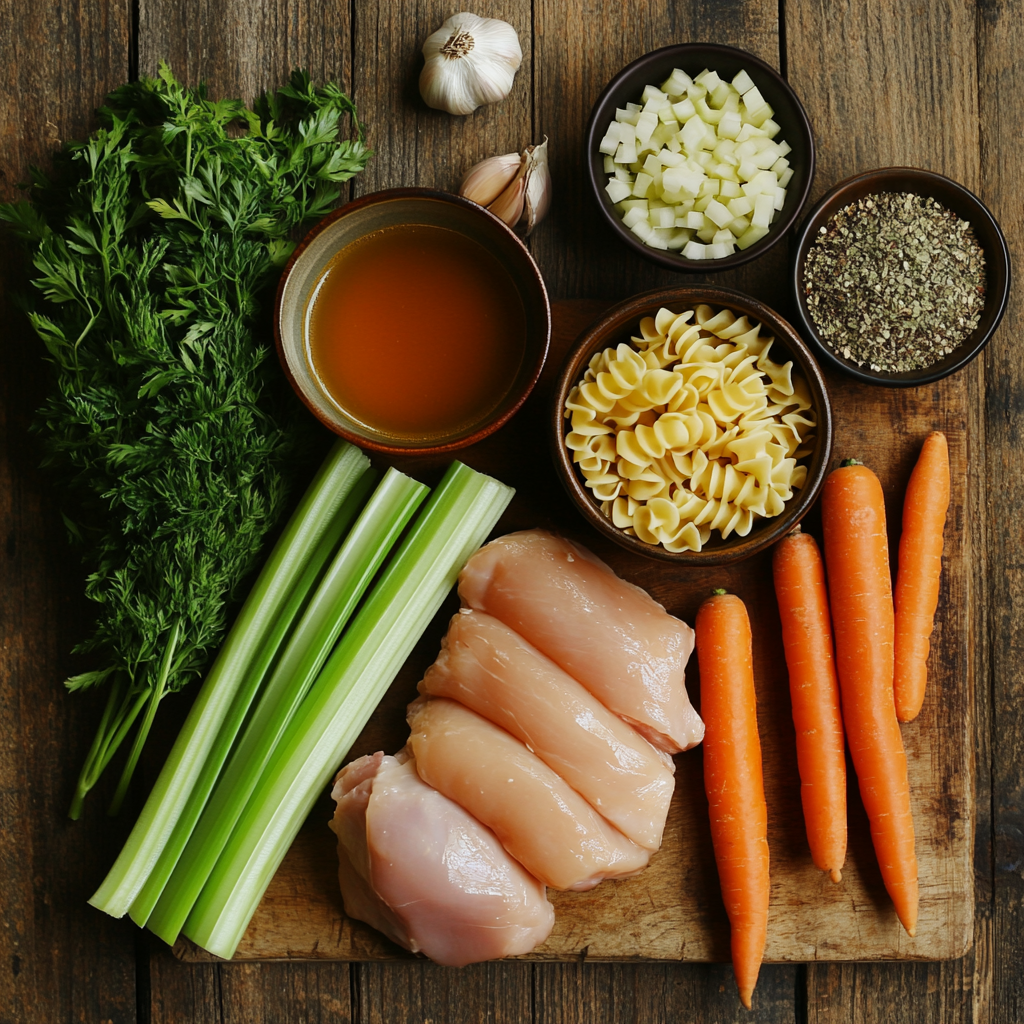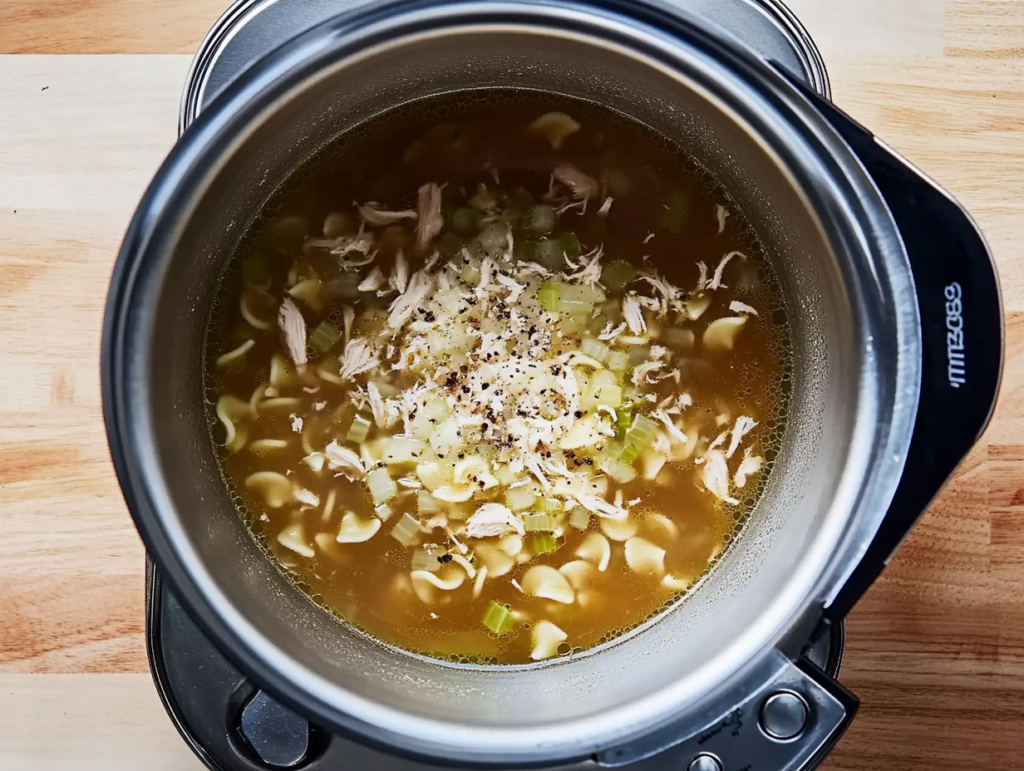Introduction
There’s nothing quite as comforting as a warm bowl of Chicken Noodle Soup. This timeless dish has been cherished for generations, offering the perfect balance of tender chicken, hearty noodles, and flavorful broth. Whether you’re feeling under the weather, looking for a quick family dinner, or simply craving something wholesome, this soup is always a good idea.
In this guide, we’ll explore everything you need to know about Chicken Noodle Soup, from its nutritional benefits to the step-by-step recipe. You’ll also discover tips, variations, and answers to common questions to ensure your soup turns out perfect every time. Let’s dive into the wonderful world of this classic comfort food.
For another wholesome chicken dish, explore our Avocado and Roast Chicken Recipes for inspiration.
Health Benefits of Chicken Noodle Soup
Nutritional Profile of Chicken Noodle Soup
- Protein-Packed: The chicken in Chicken Noodle Soup provides high-quality protein, essential for muscle repair and overall health.
- Rich in Vitamins and Minerals: Ingredients like carrots, celery, and onions contribute essential nutrients, such as vitamin A, vitamin C, and potassium.
- Low Calorie, High Satisfaction: With a broth-based recipe, this soup is filling yet low in calories, making it a healthy choice.
Healing Properties of Chicken Noodle Soup
- Cold and Flu Relief: Studies suggest that Chicken Noodle Soup can help alleviate cold symptoms by reducing inflammation and clearing nasal congestion.
- Hydration and Comfort: The warm broth hydrates and soothes, offering a sense of relief during illness.
- Boosts Immunity: The combination of chicken, vegetables, and herbs supports a healthy immune system
If you’re craving something sweet to balance your meal, pair this soup with our Cream Cheese Stuffed French Toast Recipe.
Essential Ingredients for Chicken Noodle Soup
Choosing the Right Chicken
- Whole Chicken: Using a whole chicken provides a rich, flavorful broth and tender meat for your soup.
- Chicken Breasts or Thighs: For convenience, opt for boneless, skinless chicken breasts or thighs. Thighs offer a juicier option, while breasts are leaner.
- Rotisserie Chicken: A pre-cooked rotisserie chicken can be shredded and added for a quick and easy option.
Selecting the Best Noodles
- Egg Noodles: The classic choice for Chicken Noodle Soup, known for their soft, chewy texture.
- Gluten-Free Noodles: For those with dietary restrictions, gluten-free noodles like rice or quinoa noodles are excellent alternatives.
- Other Pasta Options: Small pasta shapes such as orzo, ditalini, or spaghetti broken into pieces can also be used.
Vegetables That Add Flavor
- Carrots, Celery, and Onion: These three form the base of the soup, adding sweetness and depth to the broth.
- Optional Additions:
- Garlic: For added aroma and flavor.
- Green Beans or Corn: To enhance texture and color.
- Spinach or Kale: Stir in during the final minutes for a nutrient boost.
Crafting the Perfect Broth
- Homemade Stock: Simmer chicken bones, vegetables, and herbs for a deeply flavorful base.
- Store-Bought Broth: A time-saving option that works well when enhanced with additional herbs and spices.
- Seasoning: Use salt, black pepper, bay leaves, and fresh herbs like thyme and parsley to elevate the flavor.
For a sweet and savory chicken recipe, try our Honey Pineapple Baked Chicken Recipe to switch things up.
Step-by-Step Recipe for Homemade Chicken Noodle Soup
Preparation: Gather and Prep Ingredients
- Chop the Vegetables: Dice carrots, celery, and onions into uniform pieces to ensure even cooking. Mince garlic if using.
- Prepare the Chicken: If using raw chicken, trim any excess fat. For cooked chicken, shred or cube it into bite-sized pieces.
- Cook the Noodles Separately: Boil the noodles in salted water until slightly undercooked. This prevents them from becoming mushy when added to the soup.
Cooking Instructions
Step 1: Sauté the Vegetables
Begin by heating olive oil or butter in a large pot over medium heat. Once the oil is hot, add diced onions, carrots, and celery. Allow the vegetables to soften for about 5 minutes while stirring occasionally. Finish by adding minced garlic and cooking for an additional minute until fragrant.
Step 2: Add Broth and Simmer
Pour chicken broth or homemade stock into the pot, ensuring the vegetables are fully submerged. Include bay leaves, fresh thyme, and a pinch of salt and pepper to enhance the flavor. Bring the mixture to a gentle boil, then reduce the heat and let it simmer for 20–25 minutes to develop a rich, hearty taste.
Step 3: Cook the Chicken
For raw chicken, carefully place it into the simmering broth and cook until it reaches an internal temperature of 165°F (75°C), about 15–20 minutes. If using pre-cooked chicken, shred it into bite-sized pieces and add it during the last 5 minutes of simmering. Ensure the chicken absorbs the flavors of the broth before moving to the next step.
Step 4: Add the Noodles
Gently stir in the pre-cooked noodles, ensuring they are evenly distributed in the soup. Let the noodles warm through for 2–3 minutes before serving. Adjust seasoning if needed by adding more salt, pepper, or fresh herbs.
Serving Suggestions
- Garnish: Sprinkle fresh parsley or thyme over the soup for a pop of color and flavor.
- Accompaniments: Serve with crusty bread, crackers, or a side salad for a complete meal.
- Presentation Tip: Ladle the soup into bowls and add a lemon wedge on the side for a burst of brightness.
Variations of Chicken Noodle Soup
Regional Twists on the Classic
- Asian-Inspired Chicken Noodle Soup:
- Replace egg noodles with rice noodles or udon.
- Add ginger, soy sauce, and sesame oil for an umami-rich broth.
- Garnish with green onions, cilantro, and a soft-boiled egg.
- European-Style Chicken Soup:
- Use orzo or gnocchi as the base instead of traditional noodles.
- Add leeks and parsley for a lighter, herbaceous twist.
- Southwestern Chicken Soup:
- Incorporate black beans, corn, and diced tomatoes for a Tex-Mex flair.
- Add a dash of chili powder or smoked paprika for a spicy kick.
Dietary Modifications
- Gluten-Free Chicken Noodle Soup:
- Swap regular noodles with gluten-free options like rice or quinoa noodles.
- Ensure the broth is gluten-free if using store-bought.
- Low-Sodium Soup:
- Use low-sodium chicken broth or homemade stock to control the salt level.
- Season with fresh herbs, garlic, and lemon juice to enhance flavor without adding salt.
- Vegetarian or Vegan Alternative:
- Replace chicken with plant-based protein like tofu or jackfruit.
- Use vegetable broth instead of chicken broth.
- Add extra vegetables like zucchini, mushrooms, or bell peppers for added texture and nutrition.
Adding Unique Flavors
- Creamy Chicken Noodle Soup:
- Stir in heavy cream or coconut milk for a creamy texture.
- Add grated Parmesan cheese for extra richness.
- Spicy Chicken Soup:
- Incorporate diced jalapeños or a few drops of hot sauce.
- Sprinkle crushed red pepper flakes for added heat.
Tips for the Perfect Chicken Noodle Soup
Avoiding Common Mistakes
- Don’t Overcook the Noodles: Always cook the noodles separately and add them to the soup just before serving. This prevents them from becoming mushy.
- Season Gradually: Add salt and spices in small amounts throughout the cooking process to build layers of flavor without over-salting.
- Skim the Broth: If using raw chicken, skim off any foam or impurities that rise to the surface for a cleaner, clearer broth.
Enhancing the Flavor
- Use Fresh Herbs: Fresh thyme, parsley, or dill can elevate the soup’s aroma and taste. Add them toward the end of cooking for the best results.
- Roast the Chicken First: Roasting the chicken with a drizzle of olive oil and spices before adding it to the soup intensifies its flavor.
- Add Umami: Include a splash of soy sauce, fish sauce, or a small amount of miso paste to deepen the broth’s flavor profile.
Texture Tips
- For a Thicker Soup: Mix a tablespoon of cornstarch with cold water and stir it into the broth, letting it simmer until it thickens slightly.
- For Extra Creaminess: Add a dollop of sour cream or a splash of half-and-half just before serving.
Storing and Reheating Chicken Noodle Soup
Proper Storage Techniques
- Refrigeration: Allow the soup to cool completely before transferring it to an airtight container. Store in the refrigerator for up to 3–4 days.
- Freezing: For longer storage, freeze the soup (without the noodles) in freezer-safe containers. It can last up to 3 months.
- Portion Control: Divide the soup into individual servings before freezing for easy reheating.
Reheating Instructions
- Stovetop Method: Pour the soup into a pot and warm it over medium heat, stirring occasionally. If the soup is frozen, thaw it in the refrigerator overnight first.
- Microwave Method: Transfer a portion to a microwave-safe bowl, cover loosely, and heat in 1-minute intervals, stirring in between until hot.
- Reheat Noodles Separately: To maintain their texture, reheat the noodles separately and add them to the soup just before serving.
Tips for Maintaining Freshness
- Adjust Consistency: Add a splash of broth or water if the soup has thickened during storage.
- Re-season After Reheating: Reheated soup may lose some of its flavor, so taste and adjust with salt, pepper, or fresh herbs as needed.
- Label and Date: Always label frozen soup with the preparation date to keep track of freshness.
Reheat your soup alongside our Avocado and Roast Chicken Recipes for a comforting dinner spread.
Frequently Asked Questions (FAQs)
Can I use rotisserie chicken for Chicken Noodle Soup?
Yes, rotisserie chicken is a convenient option. Simply shred the cooked chicken and add it to the soup during the final 5 minutes of cooking to warm it through. This saves time and still delivers a delicious result.
How can I make Chicken Noodle Soup gluten-free?
To make this soup gluten-free:
- Use gluten-free noodles like rice noodles or quinoa pasta.
- Check that your chicken broth is certified gluten-free, as some store-bought options may contain hidden gluten.
What’s the best way to add depth to the broth?
Enhance the flavor of your broth with these tips:
- Add a splash of soy sauce or Worcestershire sauce for umami.
- Simmer the soup with a Parmesan rind or dried mushrooms.
- Use homemade chicken stock, as it is richer and more flavorful than store-bought versions.
How long can I store homemade Chicken Noodle Soup?
You can store it in the refrigerator for 3–4 days or freeze it for up to 3 months. For best results, freeze the soup without the noodles and add freshly cooked noodles when reheating.
Can I make this soup in a slow cooker?
Absolutely! Combine all ingredients except the noodles in a slow cooker and cook on low for 6–8 hours or high for 3–4 hours. Add pre-cooked noodles during the last 15 minutes of cooking to prevent them from overcooking.
Conclusion
Why Chicken Noodle Soup Will Always Be a Favorite
Chicken Noodle Soup isn’t just a meal; it’s a comforting experience. Its combination of tender chicken, flavorful broth, and hearty noodles makes it a classic that satisfies both the body and soul. Ideal for cozy evenings or family gatherings, this dish also works beautifully for a quick, nourishing lunch. Its timeless appeal ensures it remains a go-to option for all occasions.
The Versatility of This Recipe
One of the best aspects of this soup is its adaptability. From gluten-free and dairy-free options to regional twists like Asian-inspired broths or Tex-Mex flavors, Chicken Noodle Soup can cater to any palate. Whether you’re preparing it from scratch or using shortcuts like rotisserie chicken, this dish offers flexibility and deliciousness in every bowl.
Share Your Version
It’s your turn to make this comforting classic your own. Experiment with variations, add your favorite ingredients, or follow the traditional recipe. Don’t forget to share your experiences and favorite tips with friends and family—after all, comfort food is best enjoyed together.
For more chicken-inspired dishes, explore our Honey Pineapple Baked Chicken Recipe or pair your soup with a cozy brunch item like our Cream Cheese Stuffed French Toast Recipe. Happy cooking!



